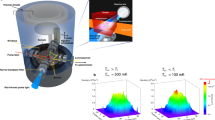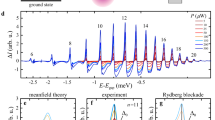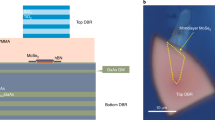Abstract
The coupling of electrons to matter lies at the heart of our understanding of material properties such as electrical conductivity. Electron–phonon coupling can lead to the formation of a Cooper pair out of two repelling electrons, which forms the basis for Bardeen–Cooper–Schrieffer superconductivity1. Here we study the interaction of a single localized electron with a Bose–Einstein condensate and show that the electron can excite phonons and eventually trigger a collective oscillation of the whole condensate. We find that the coupling is surprisingly strong compared to that of ionic impurities, owing to the more favourable mass ratio. The electron is held in place by a single charged ionic core, forming a Rydberg bound state. This Rydberg electron is described by a wavefunction extending to a size of up to eight micrometres, comparable to the dimensions of the condensate. In such a state, corresponding to a principal quantum number of n = 202, the Rydberg electron is interacting with several tens of thousands of condensed atoms contained within its orbit. We observe surprisingly long lifetimes and finite size effects caused by the electron exploring the outer regions of the condensate. We anticipate future experiments on electron orbital imaging, the investigation of phonon-mediated coupling of single electrons, and applications in quantum optics.
This is a preview of subscription content, access via your institution
Access options
Subscribe to this journal
Receive 51 print issues and online access
$199.00 per year
only $3.90 per issue
Buy this article
- Purchase on Springer Link
- Instant access to full article PDF
Prices may be subject to local taxes which are calculated during checkout



Similar content being viewed by others
References
Bardeen, J., Cooper, L. N. & Schrieffer, J. R. Theory of superconductivity. Phys. Rev. 108, 1175–1204 (1957)
Reif, F. & Meyer, L. Study of superfluidity in liquid He by ion motion. Phys. Rev. 119, 1164–1173 (1960)
Rayfield, G. W. & Reif, F. Evidence for the creation and motion of quantized vortex rings in superfluid helium. Phys. Rev. Lett. 11, 305–308 (1963)
Fisher, D. S., Halperin, B. I. & Platzman, P. M. Phonon-ripplon coupling and the two-dimensional electron solid on a liquid-helium surface. Phys. Rev. Lett. 42, 798–801 (1979)
Platzman, P. M. & Dykman, M. I. Quantum computing with electrons floating on liquid helium. Science 284, 1967–1969 (1999)
Robert, A. et al. A Bose-Einstein condensate of metastable atoms. Science 292, 461–464 (2001)
Ciampini, D. et al. Photoionization of ultracold and Bose-Einstein-condensed Rb atoms. Phys. Rev. A 66, 043409 (2002)
Zipkes, C., Palzer, S., Sias, C. & Köhl, M. A trapped single ion inside a Bose-Einstein condensate. Nature 464, 388–391 (2010)
Ratschbacher, L., Zipkes, C., Sias, C. & Köhl, M. Controlling chemical reactions of a single particle. Nature Phys. 8, 649–652 (2012)
Härter, A. et al. Single ion as a three-body reaction center in an ultracold atomic gas. Phys. Rev. Lett. 109, 123201 (2012)
Shin, Y., Schunck, C. H., Schirotzek, A. & Ketterle, W. Tomographic rf spectroscopy of a trapped Fermi gas at unitarity. Phys. Rev. Lett. 99, 090403 (2007)
Schirotzek, A., Wu, C.-H., Sommer, A. & Zwierlein, M. W. Observation of Fermi polarons in a tunable Fermi liquid of ultracold atoms. Phys. Rev. Lett. 102, 230402 (2009)
Massignan, P., Pethick, C. J. & Smith, H. Static properties of positive ions in atomic Bose-Einstein condensates. Phys. Rev. A 71, 023606 (2005)
Amaldi, E. & Segrè, E. Effect of pressure on high terms of alkaline spectra. Nature 133, 141 (1934)
Fermi, E. Sopra lo spostamento per pressione delle righe elevate delle serie spettrali. Nuovo Cim. 11, 157–166 (1934)
Greene, C. H., Dickinson, A. S. & Sadeghpour, H. R. Creation of polar and nonpolar ultralong-range Rydberg molecules. Phys. Rev. Lett. 85, 2458–2461 (2000)
Bendkowsky, V. et al. Observation of ultralong-range Rydberg molecules. Nature 458, 1005–1008 (2009)
Bendkowsky, V. et al. Rydberg trimers and excited dimers bound by internal quantum reflection. Phys. Rev. Lett. 105, 163201 (2010)
Butscher, B. et al. Lifetimes of ultralong-range Rydberg molecules in vibrational ground and excited states. J. Phys. At. Mol. Opt. Phys. 44, 184004 (2011)
Saffman, M., Walker, T. G. & Mølmer, K. Quantum information with Rydberg atoms. Rev. Mod. Phys. 82, 2313–2363 (2010)
Bahrim, C., Thumm, U. & Fabrikant, I. I. 3S e and 1S e scattering lengths for e− + Rb, Cs and Fr collisions. J. Phys. At. Mol. Opt. Phys. 34, L195–L201 (2001)
Beterov, I. I., Ryabtsev, I. I., Tretyakov, D. B. & Entin, V. M. Quasiclassical calculations of blackbody-radiation-induced depopulation rates and effective lifetimes of Rydberg ns, np, and nd alkali-metal atoms with n ≤ 80. Phys. Rev. A 79, 052504 (2009)
Honer, J., Löw, R., Weimer, H., Pfau, T. & Büchler, H. P. Artificial atoms can do more than atoms: deterministic single photon subtraction from arbitrary light fields. Phys. Rev. Lett. 107, 093601 (2011)
Reinhard, A. et al. Double-resonance spectroscopy of interacting Rydberg-atom systems. Phys. Rev. Lett. 100, 233201 (2008)
Löw, R. et al. An experimental and theoretical guide to strongly interacting Rydberg gases. J. Phys. At. Mol. Opt. Phys. 45, 113001 (2012)
Acknowledgements
We thank K. Rzążewski and J. Hecker Denschlag for discussions and C. Tresp for setting up the Rydberg laser system. This work was funded by the Deutsche Forschungsgemeinschaft (DFG) within SFB/TRR21 and project PF 381/4-2. We also acknowledge support by the ERC under contract number 267100, and A.G. acknowledges support from EU Marie Curie programme ITN-Coherence 265031. S.H. is supported by the DFG through project HO 4787/1-1.
Author information
Authors and Affiliations
Contributions
The experiment was conceived by J.B.B., R.L., S.H. and T.P. and carried out by J.B.B., A.T.K. and A.G.; data analysis was accomplished by J.B.B., A.T.K. and A.G.; perturbation theory was developed by D.P. and H.P.B.; and J.B.B. and D.P. wrote the manuscript with contributions from all authors.
Corresponding author
Ethics declarations
Competing interests
The authors declare no competing financial interests.
Supplementary information
Supplementary Information
This file contains Supplementary Text and Data, which includes a Supplementary Discussion, Supplementary Figures 1-2 and additional references. (PDF 214 kb)
Rights and permissions
About this article
Cite this article
Balewski, J., Krupp, A., Gaj, A. et al. Coupling a single electron to a Bose–Einstein condensate. Nature 502, 664–667 (2013). https://doi.org/10.1038/nature12592
Received:
Accepted:
Published:
Issue Date:
DOI: https://doi.org/10.1038/nature12592
This article is cited by
-
Collective Excitations of Bose–Einstein Condensate in a Rydberg Atom
Journal of Low Temperature Physics (2024)
-
Scalable quantum processors empowered by the Fermi scattering of Rydberg electrons
Communications Physics (2023)
-
Functional determinant approach investigations of heavy impurity physics
AAPPS Bulletin (2023)
-
Micro–micro and micro–macro entanglement witnessing via the geometric phase in an impurity-doped Bose–Einstein condensate
Quantum Information Processing (2022)
-
Controlling quantum coherence of a two-component Bose–Einstein condensate via an impurity atom
Quantum Information Processing (2020)
Comments
By submitting a comment you agree to abide by our Terms and Community Guidelines. If you find something abusive or that does not comply with our terms or guidelines please flag it as inappropriate.



